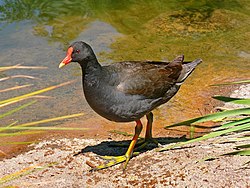Dusky moorhen
| Dusky moorhen | |
|---|---|
 |
|
| Scientific classification | |
| Kingdom: | Animalia |
| Phylum: | Chordata |
| Class: | Aves |
| Order: | Gruiformes |
| Family: | Rallidae |
| Genus: | Gallinula |
| Species: | G. tenebrosa |
| Binomial name | |
|
Gallinula tenebrosa Gould, 1846 |
|
| Synonyms | |
|
Gallinula haematopus Bonaparte, 1856 |
|
Gallinula haematopus Bonaparte, 1856
Gallinula tenebrosa magnirostris Mathews, 1912
Gallinula tenebrosa subfrontata Mathews, 1912
The dusky moorhen (Gallinula tenebrosa) is a bird species in the rail family and is one of the eight extant species in the moorhen genus. It occurs in India, Australia, New Guinea, Borneo and Indonesia. It is often confused with the purple swamphen and the Eurasian coot due to similar appearance and overlapping distributions. They often live alongside birds in the same genus, such as the Tasmanian nativehen and the common moorhen.
John Gould described the dusky moorhen in 1846 from a skin collected along the Murray River in South Australia. Its species name is derived from the Latin tenebrosa "dark". Charles Lucien Bonaparte described Gallinula haematopus in 1856, but this is now a nomen nudum. Gregory Mathews described two subspecies that have been synonymized—magnirostris from Western Australia and subfrontata from New South Wales.
Three subspecies are recognised: subspecies frontata from southeastern Borneo, the Sunda Islands, Timor and western New Guinea, subspecies neumannii from northern New Guinea, and the nominate subspecies from Australia.
Common names include dusky moorhen, black gallinule, black moorhen and waterhen.
The dusky moorhen is a medium size bird, slightly smaller than the purple swamphen. The New Guinea birds are smaller, at 25–32 centimetres (9.8–12.6 in) in length, than the Australian race 34–38 centimetres (13–15 in). Adult males generally weigh on average around 570 grams and adult females 493 grams. The adult dusky moorhen is mainly dark grey-black, with a browner tinge to the upper parts. It has a red frontal shield and yellow-tipped red bill like its Eurasian relative, but lacks the white flank line shown by common moorhen, and has orange-yellow rather than yellow legs. The Australian subspecies is larger and pager than both other subspecies.
...
Wikipedia

